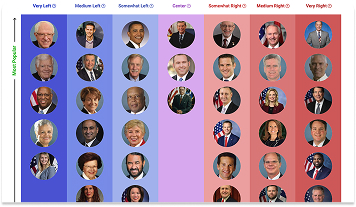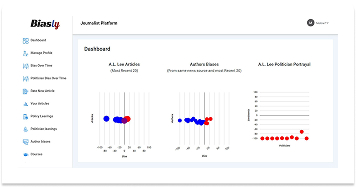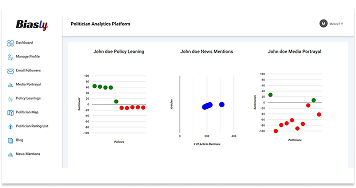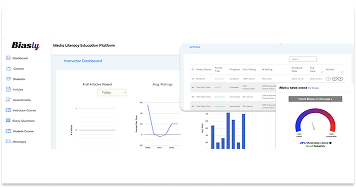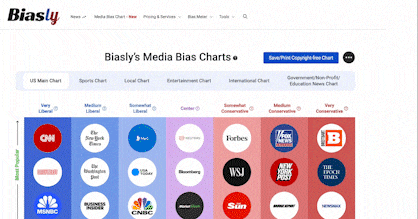Bias Meter
Extremely
Liberal
Very
Liberal
Somewhat Liberal
Center
Somewhat Conservative
Very
Conservative
Extremely
Conservative
-100%
Liberal
100%
Conservative
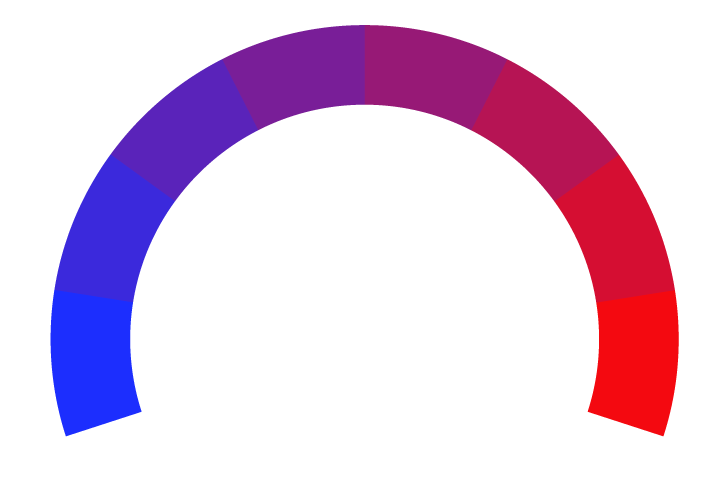
Biasly determines media bias ratings through a dual-layered approach combining artificial intelligence and analyst review. The platform’s proprietary bias detection engine, Bias Meter, evaluates sentiment, policy position alignment, and language framing across thousands of data points in news articles. Analysts then verify and interpret the AI’s findings, providing additional context where needed. Learn more
- Profile
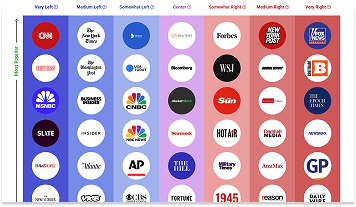
Reuters on the media bias chart
Reuters has a Bias Score of -2% Center which is based on a variety of factors including its policy and politician leanings, article ratings, and the use of biased language. Its Reliability is rated as Good, and additional analytical insights are available in the other tabs.
- Bias Rating
-2% Center
- ReliabilityPolicy Leanings
8% Center
Extremely
LiberalVery
LiberalModerately
LiberalSomewhat Liberal
Center
Somewhat Conservative
Moderately
ConservativeVery
ConservativeExtremely
Conservative-100%
Liberal100%
Conservative
Average Reliability
*Our bias meter rating uses data science including sentiment analysis, machine learning and our proprietary algorithm for determining biases in news articles. Bias scores are on a scale of -100% to 100% with higher negative scores being more liberal and higher positive scores being more conservative and 0% being neutral. The rating is an independent analysis and is not affiliated nor sponsored by the news source or any other organization.
Politician Portrayal52% positive
Continue For Free
Create your free account to see the in-depth bias analytics and more.
By creating an account, you agree to our Terms and Privacy Policy, and subscribe to email updates.
Policy Leanings Analysis
Policy | Bias score |
|---|
Reuters Editorial Patterns
Reuters coverage of political topics often reflects a Center bias, with consistent patterns in phrasing, source selection, and varied thematic focuses that are Neutral. While the publication demonstrates journalistic standards in a majority of its reports, the coverage of domestic issues can occasionally indicate a political slant. This content analysis examines how Reuters handles liberal and conservative issues and evaluates its language choices and editorial tendencies.
Coverage of Liberal vs. Conservative Topics
Reuters coverage sometimes emphasizes liberal priorities like abortion rights or charter schools, providing more detail than conservative counterparts. Analysts observed consistent objectivity on topics like affirmative action and clean energy, where Reuters relied on factual language and authoritative sourcing. Such consistency demonstrates adherence to Reuters’ Trust Principles, emphasizing accuracy, fairness, and independence across politically sensitive subjects.
Conservative-linked policies, including immigration enforcement or deregulation, often receive balanced treatment through direct quotes from officials and contextual legal analysis. For example, articles on detention centers and Trump’s birthright citizenship order cited both supportive and opposing perspectives without editorializing. By presenting official rulings, administration statements, and advocacy responses, Reuters reinforces credibility while avoiding overt partisan lean.
Biasly’s evaluations highlight these differences, showing liberal coverage sometimes receives expanded detail while conservative coverage is presented with stricter neutrality. This subtle contrast reflects modern journalistic challenges: representing diverse political perspectives while maintaining Reuters’ Center bias rating and Good Reliability Score.
Policy and Issue Framing
Reuters frames policy topics by combining official statements, court rulings, expert commentary, and historical context to maintain factual accuracy. Articles on immigration, economic regulation, social programs, and international policy emphasize legal precedent, historical trends, and measurable outcomes rather than emotional language. This approach relies heavily on primary sources to remain credible. However, individuals or groups not directly making policy decisions often have fewer resources or less verifiable data. This challenge limits some voices’ ability to be included without reducing reliability.
While some topics receive more detailed coverage from liberal perspectives, conservative viewpoints are consistently included through direct quotes, administration statements, and official data. Omitting non-decision-making voices could create an imbalanced perspective, but Reuters carefully navigates this tension by including credible sources while maintaining transparency. Even when selection or omission choices subtly shape narratives, the outlet frames stories with context, clarifying policy impacts and potential consequences.
Coverage and Relevance
Reuters delivers expansive reporting across politics, business, technology, science, health, sports, crime, and entertainment, producing content in 12 languages for audiences worldwide. Its global presence allows coverage of local, national, and international developments. For Reuters, reporting beyond partisan debates looks like global economic trends, climate change, migration, and public health issues.
The outlet’s network of journalists, bureaus, and partnerships provides access to primary sources, official statements, court rulings, and expert commentary. As AI becomes more prominent in news production, Reuters implements tools to support accuracy and reduce algorithmic bias. At the same time, the newsroom is increasingly equipped with employees from diverse backgrounds. Its 2023 Diversity Report detailed how this enables more rigorous coverage and representation of minority perspectives and social justice concerns.
Reuters Bias Analysis
Founded in 1851, Reuters is one of the world’s largest international news networks. Today, it reaches readers through 100+ global news partners, with coverage spanning politics, business, technology, science, health, sports, crime, and entertainment. Reuters journalists operate in 165 countries and produce content in 12 languages for diverse audiences worldwide.
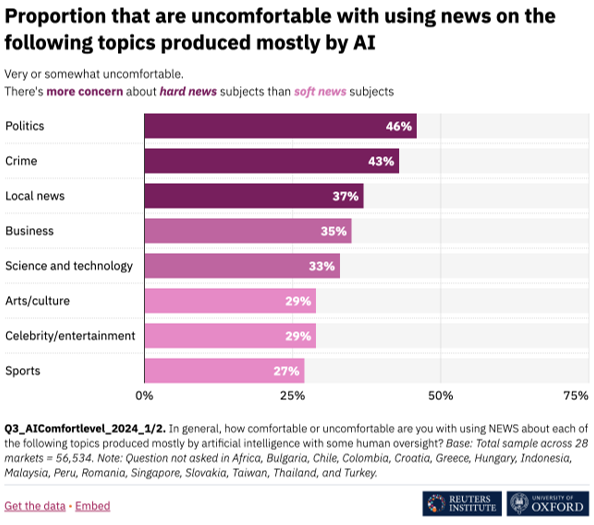
Source: Reuters Institute
According to the Institute’s 2024 report, politics is the least trusted news topic online since the rise of AI. Reuters addresses this concern through its Trust Principles, established in 1941 to preserve accuracy, independence, and integrity in reporting. These principles guide journalists in delivering unbiased, factual coverage to media, governments, businesses, and the public.
Reuters embraces AI-driven tools while collaborating across editorial and technical teams to identify and correct algorithmic bias. It has set 2023–2025 goals to increase leadership diversity, expand internal promotions, and strengthen inclusive global coverage. Initiatives include the Global Race and Justice team, leadership training, and partnerships supporting underrepresented talent in journalism. Under President Paul Bascobert, Reuters continues expanding its global reach while modernizing operations for a rapidly evolving news environment.
Is Reuters Biased?
Based on Biasly’s evaluations, Reuters is rated as Center.
By examining content patterns and the broader context of media influence, we aim to offer a balanced perspective on Reuters’ political bias—and contribute to the ongoing discussion about bias in the news.
How Does Biasly Rate News Sources?
Biasly uses proprietary algorithms and a team of analysts to provide comprehensive bias evaluations across thousands of news outlets. Over 200,000 articles from more than 3,200 sources have been analyzed to identify the most accurate and unbiased stories.
Biasly assigns each outlet three key scores:
- Reliability Score – Reflects factual accuracy
- AI Bias Score – Generated via natural language processing
- Analyst Bias Score – Assessed by human political analysts
These scores are based on seven core metrics: Tone, Tendency, Diction, Author Check, Selection/Omission, Expediency Bias, and Accuracy. These elements help analysts and algorithms evaluate the political attitude conveyed by each article.
Biasly’s Bias Meter ranges from -100% (most left) to +100% (most right), with 0% indicating neutrality. The system evaluates individual articles based on political terms, policies, figures, and sentiment to calculate precise bias ratings.
Is Reuters Politically Biased?
Reuters earns a Center rating for its AI Bias Score and a Center rating for its Analyst Bias Score. The Analyst Bias Score is generated by reviewers from liberal, moderate, and conservative backgrounds. Analysts reviewed 15 Reuters articles and noted preferences in areas like coverage of liberal politicians and policy topics such as abortion rights and charter schools. However, the paper maintained objectivity on most topics, like affirmative action and clean energy.
Being a news outlet based outside of the United States allows Reuters to report objectively on domestic politics within America more easily. Reuters maintains a reputation for center, unbiased reporting. Its editors especially ensure balance on sensitive issues like the Israel-Palestine conflict, which is a highly polarizing topic for Americans. James Mackenzie, Reuters’ Bureau Chief for Israel and the Palestinian Territories, noted in the 2023 Diversity Report,
“While it has not always been smooth, the level of professionalism displayed by everyone is commendable.”
Statements like this from various employees reflect Reuters’ commitment to address complex issues with factual journalism. Involving Israelis, Palestinians, Jews, Muslims, Christians, etc, is one way the newsroom prevented omission bias for such coverage.
Further initiatives to reinforce Reuters’ journalistic integrity, as stated in its report, may be associated with liberal values. Inclusivity and diversity have become the face of many recent campaigns for the Democratic Party, causing trepidation among more conservative readers. However, Reuters concludes controversial articles with a mention of its Trust Principles to emphasize freedom from bias.
A Reuters employee expressed the need to declare truth with confidence in ‘A journalistic revolution.’ They gave historical context, describing the reactionary movement in the 70’s and 80’s producing “toothless, spineless journalism.” In essence, the concern is that being driven by a fear of bias impairs the media’s ability to debunk lies. The article explains that making truth relative accepts the reality of bias, but attributes too much power to it.
“So when an editor says that there are facts and there is such a thing as truth, he is pushing back against at least 30 years of journalism and as many years of critical theory… but if the news media did, it would reshape our journalistic environment into one in which expertise matters, facts are verifiable, and opinions must be supported in order to be aired.”
Reuters firmly believes in objective truth and upholds journalistic standards despite potential criticism. The article makes a key point: the media must accept the reality of bias without surrendering to it. Reuters strives for journalistic integrity by balancing preventative measures like diverse newsrooms and accuracy checks with bold reporting.
Analysis of Bias in Reuters Online Articles
The increasingly polarized political landscape in the United States presents globally-minded outlets like Reuters with many challenges. The transition of political powers tends to introduce new concerns, as well as a host of policy decisions. So as readers scramble to stay informed, it is vital to ask: Reuters truly biased?
To evaluate this, we can analyze select Reuters articles through several of Biasly’s bias rating criteria: Tone, Tendency, Author, Diction, and Expediency Bias.
- Tone: The overall attitude conveyed by the article
- Diction: Specific word choices made by the writer
- Author: The background and social presence of the journalist
- Tendency: Patterns of bias in the writer’s broader body of work
- Expediency Bias: Quick visual or textual indicators like headlines and photos that imply bias

Source: Reuters
This Reuters article covers legal battles over Trump’s birthright citizenship order. The cover photo displays demonstrators protesting outside the Supreme Court. Although this leaves a sympathetic first impression on readers, the author begins with a factual update. Nate Reymond covers the incident primarily from the judicial decisions before including views from either side. Citing court rulings and judges’ opinions maintains factual accuracy and transparency about the judicial process.
“Boardman, an appointee of Democratic President Joe Biden, in her February decision said Trump’s order interpreted the citizenship clause of the U.S. Constitution’s Fourteenth Amendment ‘in a manner that the Supreme Court has resoundingly rejected and no court in the country has ever endorsed.“
The article is strategic in its selection by focusing mainly on legal challenges from Democratic advocates and rulings by Democratic-appointed judges. It highlights Judge Boardman’s decisions and critiques of President Trump’s constitutional interpretation. However, it gives less detail about conservative or administrative arguments.
One explanation for this could be that conservative arguments have already been the focal point of stories covering the president’s original order. For example, Reuters released a video two months prior covering the decision in detail. Therefore, readers must understand the context when analyzing headlines and bias in articles. While this headline focuses on current judicial opposition, the outlet assumes its audience is well-read on the issue as a whole.
Phrases like “swiftly challenged” and “hardline immigration agenda” subtly suggest the controversy of the conflict. However, limiting mention of citizen reactions redirects attention from emotional catalysts to factual analysis. Overall, Reymond conveys that the primary objective is to update readers on political developments without drastically influencing their views.
In another article, Idrees Ali covers the “Trump administration plans to build largest US federal migration detention center on military base.” This article similarly covers immigration in the US, but shifts gears to discuss the implementation of Trump’s laws.
The cover photo is the most noticeable difference: Trump stands alone in front of a detention center. The Image does not appear to make a statement, but merely to capture the story’s subject. Reuters stands apart from many left-leaning news outlets in this decision, which tend to depict struggling immigrants to evoke sympathy in their readers. Ali quotes Kingsley Wilson, a Pentagon spokesperson, stating,
“Upon completion, this will be the largest federal detention center in history for this critical mission – the deportation of illegal aliens.”
This statement succinctly conveys the administration’s intention to emphasize the scale and seriousness of the project. Ali’s language is official and factual, and presents the facility as a necessary step in managing immigration enforcement. He sticks closely to the spokesperson’s words without additional information according to his personal preferences.
The article highlights how the Trump administration frames these measures as critical to national security, without adopting that perspective itself. This allows readers to understand the policy’s scope and significance without drawing direct conclusions from the source. Noting that migrant detention on military bases continued under President Biden’s administration also prevents the narrative from appearing one-sided.
Compared to the previous article about the birthright citizenship order, this piece remains similarly objective and concise. However, including contextual information strengthens depth and balance. Limiting the political actors in the cover photo also prevented showing relational dynamics in a positive or negative light.
Even on a topic as contentious as immigration, Reuters maintains its journalistic standard of impartiality. For Ali, who is Pakistani according to his profile with Reuters, personal experiences could shape his perspectives on immigration. Ali’s Twitter page signals a strong focus on Palestine, which tends to resonate with liberal-minded audiences. However, the majority of his posts cite articles or primary sources. Therefore, while he may lean liberal, Ali refrains from expressing personal opinions in the article above.
“Tomorrow will be better,” he would say, even as conditions in the Palestinian enclave descended further into hunger and desperation in the months leading up to his death. That was how he ended his last conversation. https://t.co/UIShZIRKwq
— Idrees Ali (@idreesali114) August 27, 2025
Analysis of Reuters Opinion Articles
Opinion articles differ from standard news reports because they reflect an author’s perspective rather than strictly objective reporting. Readers should approach them with greater caution and evaluate potential bias separately from traditional coverage. However, not all opinion writing takes the same form. At Reuters, opinion is often presented as “commentary.” Reuters commentaries can range from critiques of economic policy to evaluations of political decisions.
Edward Chancellor’s article, Why an economic soft landing may prove elusive, is skeptical toward a U.S. “soft landing.” The article commentary has a strong start by gathering information from economist Bernard Connolly. It describes his argument that current central bank models overlook critical financial risks. Chancellor quotes Connolly:
“Intertemporal coordination breaks down when real interest rates are out of line with society’s time preference.”
Chancellor uses professional opinion to inspire caution about flawed economic assumptions. More specifically, he highlights that structural imbalances were caused in part by monetary policy decisions, and especially the prolonged period of low interest rates.
Overall, this opinion remains grounded in expert analysis and historical context. Focusing on economic models and market data rather than rhetoric, aligning with partisan views leaves less room for bias. However, Chancellor’s expectations for the future are evident, which makes, Reuters’ moderate stance on economic policy less identifiable.
Nonetheless, the absence of extreme language invites readers to consider the nuanced risks of current fiscal and monetary strategies. Keeping a measured tone maintains a centrist approach to government roles and economic regulation.
Interestingly, the commentary doesn’t end with policy critique but with investment guidance. Here is where the need for media literacy comes in, as readers must identify whether there is bias behind suggestions. After outlining Connolly’s thesis, Chancellor brings up long-dated U.S. Treasury Inflation-Protected Securities as a defensive play.
“Under those circumstances, long-dated government bonds should provide the best protection for investors.”
This move shifts the style from economic analysis to subtle advice. Chancellor implies that the looming crisis is not just a theoretical concern but a real market risk. Framing like this implies the need for a strategy responding to economic collapse. It also adds urgency to the cautious tone the article began with. Once the commentary takes an investment stance, readers must use discernment to identify potential bias. However, the author’s views seem unaffected by partisan agendas, and his sources were derived for research purposes.
The commentary title, US tariff tantrum threatens pricing progress, uses harsher language to present an immediately critical view. The author, Gabriel Ruben, critiques Trump’s tariff strategy as unpredictable and inflationary. At the same time, it acknowledges scenarios where tariffs could lead to lower global levies. Instead of treating tariffs as a partisan issue, the piece frames them through economic impacts on growth and prices. However, because the data and scenarios align directly with the author’s initial claim, this approach could reflect a form of confirmation bias.
“The rest of Trump’s agenda, like hard-to-unwind lumber and steel tariffs and immigration restrictions, risks the worst of both worlds: higher costs, lower growth.”
The tone emphasizes the economic consequences of policy development. Ruben focuses on data from government surveys, private sector forecasts, and market reactions. However, compared to the economic soft landing commentary, readers will find a sharper stance against the administration. This makes it more overtly critical than the earlier piece while primarily defending arguments pertaining to economic risk.
Who Owns Reuters?
Reuters is part of Thomson Reuters, a global information and software company formed in 2008 through a merger. The company is publicly traded, but the Thomson family maintains influence through Woodbridge, its private investment company. David Thomson, Chairman of Thomson Reuters and Woodbridge, has guided the corporation toward subscription-based information services, automation, and technology-driven solutions. He also focuses on maintaining strong capital efficiency and delivering consistent shareholder returns.
Under this ownership, Thomson Reuters has strengthened offerings in law, tax, compliance, and financial data. It also invests in acquisitions and AI-driven workflow solutions to enhance technology capabilities. Reuters’ editorial independence is safeguarded by the Trust Principles, created in 1941. According to a pamphlet in 2013,
“The owners and the Reuters Board were determined to protect and preserve the Principles established in 1941. A unique structure was put in place to achieve this. A new company was formed and given the name ‘Reuters Founders Share Company’, its purpose being to hold a ‘Founders Share’ which empowered it to restrict shareholdings to 15% and to veto certain changes to Reuters’ constitution.”
These rules ensure Reuters’ integrity, independence, and freedom from bias. Chief Executive Steve Hasker reaffirmed this priority in 2024:
“We take the Trust Principles very seriously. They are the governing set of rules that ensure the integrity of the information we provide, regardless of commercial considerations.”
As the company’s media division, Reuters delivers trusted news and analysis globally. It produces millions of stories, images, and videos annually for financial and media audiences. Paul Bascobert has served as President of Reuters since September 2022. Bascobert leads media operations and drives digital transformation initiatives across the division. Today, Reuters reaches financial firms, media organizations, and professionals worldwide. It operates from 57 offices across the globe. The company delivers content through articles, videos, and live events, providing timely and reliable global information.
How to Evaluate Bias
Although Biasly rates Center as Center, it’s important to remember that bias can vary from article to article. Reuters’ newsroom is composed of diverse backgrounds. And while this ensures better representation of the global population as a whole, it can include conflicting views. This complexity underscores the importance of examining each article individually. So, let’s learn how to evaluate media bias.
Recognizing media bias requires awareness and critical thinking. Often, readers trust news sources that affirm their existing beliefs—a psychological tendency known as confirmation bias. This makes it harder to identify slanted narratives or one-sided reporting.
To combat this, it’s essential to challenge your assumptions by consulting multiple viewpoints and verifying news through third-party analysis. Tools like Biasly’s media bias ratings allow readers to compare the same news story across the political spectrum.
Ultimately, bias isn’t always a matter of what is said—it’s also about what is left out, how topics are framed, and which stories are chosen for coverage. Learning to recognize these patterns can help readers make more informed decisions and develop greater media literacy.
To start comparing news outlets and gain a better understanding of bias, sign up for Biasly’s Media Bias & News Analytics Platform to see how stories vary between sources.
Reuters Reliability Analysis
Is Reuters Reliable?
Reuters occupies a solid position toward the middle of the reliability spectrum, consistently producing fact-based reporting across a wide range of topics. Its global reach and extensive newsroom resources allow it to verify information through primary sources, official statements, and expert commentary.
However, occasional omissions or framing choices, especially on culturally sensitive or politically charged stories, can subtly affect perception of accuracy. These nuances suggest that while Reuters is broadly reliable, readers should still assess individual articles critically. At Biasly, we evaluate both bias and factual reliability, providing tools to help readers determine how trustworthy a source like Reuters is in practice.
How to Evaluate Reliability?
Reliability refers to how trustworthy or accurate a news source is. If we can’t trust what we read, then continuing to consume content from that outlet serves little purpose. So how do we evaluate a news outlet’s reliability?
There are several potential measures of reliability to look out for when trying to determine whether a media source is reliable or not. Red flags for an unreliable article can include the presence of wild, unsubstantiated claims, facts dependent on other unreliable sources, heavy use of opinionated language, and more. In contrast, hallmarks of a reliable source include:
- Absence of subjective language
- Citing credible sources (e.g., .gov, .edu, academic references)
- Verifiable facts and statistics from multiple outlets
- Use of primary sources, like interviews or transcripts
- Consistency with coverage across other platforms
Biasly’s reliability scores incorporate these elements in evaluating media outlets.
So How Does Reuters Fare in Its Reliability?
The political reliability index developed by Biasly assesses both accuracy and trustworthiness. Reuters currently holds Good Reliability Score, which is calculated as a weighted average of:
- Fact Analysis Score – Evaluates the accuracy of claims, facts, and evidence.
- Source Analysis Score – Assesses the number, diversity, and credibility of sources and quotes used.
Reuters’ Source Analysis Score is Average at 54% Reliable. This suggests moderate trustworthiness in its sourcing practices. The score is AI-generated and considers quote length, frequency, diversity, and quality.
The Fact Analysis Score of Reuters is Excellent at 91% Reliable. This further shows how well Reuters supports its claims, addresses selection and omission bias, and presents verifiable evidence.
While Reuters consistently leans toward factual reporting, occasional lapses—such as unbalanced viewpoints or incomplete data—can affect its reliability rating. These nuances emphasize the importance of analyzing individual articles.
Reuters’ Accuracy and Reliability
According to Biasly’s analysis, Reuters maintains Good Reliability Score, but individual articles may vary significantly. Let’s dive into the details.
Political orientation plays a crucial role in how audiences perceive reliability. Conservative readers may distrust Reuters for favoring a liberal narrative, potentially at the expense of factual reporting. A Pew Research study shows “Democrats are much more likely than Republicans to both use and trust many major news sources.” To understand such claims, it’s essential to analyze whether publications as large as Reuters back their assertions with sufficient and diverse evidence.
Two common types of bias that affect factuality include:
- Selection Bias – Highlighting or omitting stories to fit a particular narrative.
- Omission Bias – Leaving out differing perspectives or relevant details to skew perception.
Biasly’s accuracy ratings use a scale from 1% (least accurate) to 100% (most accurate). Factors include the presence of supporting evidence, internal and external reliable sources, and balanced viewpoints.
For instance, Biasly gave Reuters a center and an Good. In one article titled US democratic backsliding under Trump encourages autocrats globally, democracy watchdog says Reuters presents information suggesting a correlation between Trump’s actions and the global idea of a strong leader. Similarly, Nation on edge: experts warn of “vicious spiral” in political violence after Kirk killing suggests the negative influence of repeated acts of force or violence in political discourse. However, it omits local perspectives. In more globally-focused pieces, Reuters explores potential retaliation in Middle Eastern conflicts without supporting one side. Maayan Lubell discusses the issue matter-of-factly through the words of a credible source in her article Israel will kill Hamas leaders next time if they survived Qatar attack, Israeli official says. Issues extending beyond the political range of the US highlight Reuters’ ability to bring in diverse viewpoints without heavily partisan claims. Debates related to immigration in particular have reinforced division and polarized conversation.
Lawyer says many immigrants detained at Hyundai US facility appeared to be working legally reports legal claims without offering commentary. Generalized assumptions could easily oversimplify tensions between communities from different regions. Reuters’ direct and succinct reporting provides clarity to the conversation. Despite omitting authority perspectives, the author clearly displays facts, helping readers stay up-to-date on a potentially confusing and fast-paced topic.
Analysis of Reliability in Reuters’ Online News Articles
This article, titled “US CDC under Kennedy has undergone mass layoffs, vaccine policy changes,” studies the impact of politics on the health industry. One of the first things that stands out is clear organization. The piece is sectioned into categories like ‘Mass Layoffs,’ ‘COVID Shots,’ ‘Resignations,’ ‘Autism Study,’ and ‘Security Concerns.’ Each section pairs key claims with identifiable sources, whether numbers, official statements, or personnel records. This structure makes it easy to cross-check information specifically.
Ruyaan Singh, the author, begins with a close look at how politics are reshaping the health industry. Clashes between Susan Monarez and Robert F. Kennedy spark uncertainty over the future of the CDC. The phrasing of “clash” and “ousted” implies conflicting viewpoints. However, these are unfolded in only as much as can be understood through public course of events.
Singh relies on official government statements and decisions, without quoting politicians or other public figures. However, he links Center articles that cover each decision in greater depth for readers looking to find more information. The article linked under ‘Mass Layoffs includes a quote by Kennedy,
“Over time, bureaucracies like HHS become wasteful and inefficient even when most of their staff are dedicated and competent civil servants.”
Singh’s choice of using internal links allows him to keep his article concise, as well as excluding information that, while honest, might contribute to bias. Controversial statements like Kennedy’s often stir up emotional reactions and cause division among readers. This way, readers are given access to further quotes, without prioritizing them over the general outline provided by the article.
The article highlights details like staffing figures, including the 2,400 employees who were let go, and 700 who were rehired. Such statistics are specific and verifiable, serving to strengthen the article’s factual accuracy.
This Center article provides a straightforward account of recent political changes at the CDC. Its structured layout and transparent sourcing make complex developments easier to follow and verify. This emphasis on clarity and cross-referencing reflects Center’ value for reliability and media literacy among readers.
Quality of Sources and Facts Used
The article called Trump signs memo requiring universities to disclose admissions data based on race touches on the long-time American dispute over affirmative action. This Reuters piece draws from a small but clearly defined set of sources. It cites the White House, the U.S. Department of Education, and the American Council on Education. Both government and higher education perspectives are included, giving readers direct statements from each side. Brad Brooks, the author, also quotes Jonathan Fansmith, who is a named representative of the American Council on Education. He outlines concerns about legality and compliance with the Supreme Court ruling. To balance this, it cites a senior Trump administration official offering a different interpretation. That official is anonymous, likely due to restrictions on speaking publicly. Overall, the source selection represents opposing views without editorializing.
All named sources are authoritative within their fields. Fansmith represents a large national higher education organization. The Department of Education and the White House are primary actors in the policy change. The anonymous senior official provides insight into the administration’s interpretation. Anonymity limits transparency and verifiability for readers.
The absence of academic or independent legal experts narrows the scope of perspectives. As a result, the legal implications are framed only through the involved stakeholders. Still, the piece maintains clarity and neutrality by focusing on factual statements. Each side explains its position in its own words.
This investigation, Trump’s war on Big Law leads firms to retreat from ’pro bono’ work for underdogs, draws from a more extensive base of evidence. It cites over 60 lawyer interviews and 30 nonprofit interviews. The reporters also contacted more than 70 civic groups and reviewed 50 law firm websites. They analyzed millions of court records, federal dockets, and academic research from a Notre Dame law professor. Such a high volume of sources suggests thorough fact-gathering. The mix of interviews, document reviews, and statistical analysis grounds the piece in verifiable information.
The article presents viewpoints from civil rights advocates, pro bono directors, legal ethics experts, and nonprofit leaders. It also includes perspectives from Trump administration allies and conservative activists. Critics of Big Law’s perceived liberal leanings appear alongside official government positions from the EEOC. Frequent attribution of statements to named individuals and organizations enhances transparency. However, some sources remain anonymous to protect relationships or avoid retaliation. Readers may be skeptical of quotes like this, despite promising explanations:
“At least a dozen groups reported that law firms had already backed away … though they all declined to name names, fearing they might alienate lawyers they could need in the future.”
Although opposing views are acknowledged, the weight of the reporting rests on accounts of harm to pro bono work and law firm intimidation. This choice shapes how readers interpret what could just be routine policy disputes. Presenting Trump’s actions as a challenge to legal independence suggests negative views toward him, which aligns with his Politician Rating. However, it promises readers credible sources and highly accurate content.
Here is a list of seven sources that were used:
- Dustin Rynders – Legal Director, Texas Civil Rights Project
- Steven Banks – Former head of pro bono at Paul Weiss
- Derek Muller – Law professor, University of Notre Dame
- Bridget Crawford – Director of law and policy, Immigration Equality
- Michael Lukens – Executive Director, Amica Center for Immigrant Rights
- Vanessa Batters-Thompson – Executive Director, DC Appleseed Center for Law and Justice
- B. Howard – Former Maryland Deputy Attorney General and former Cadwalader partner
Court docket analysis and firm website archives provide verifiable and independent evidence. This strengthens the article’s reliability. The author’s use of a peer-reviewed academic study adds to the factual grounding. Only some claims rely on anonymous sources. This is understandable given the political and professional stakes. Overall, Reuters meets a high standard for investigative journalism in this piece. The authors provide depth and corroboration while noting the limits of available evidence.
Selection and Omission Bias
At first glance, Israel’s security cabinet approves plan to take control of Gaza City appears neutral and straightforward. It quotes European governments, Saudi Arabia, Israeli opposition leaders, hostage families, and supportive voices like Prime Minister Netanyahu and U.S. Ambassador Mike Huckabee.
However, direct quotes from Hamas, the Palestinian authorities, or civilians living in Gaza are completely missing. The Palestinian perspective only appears indirectly through population figures and mentions of humanitarian impacts. Without these voices, readers do not get a full understanding of how those most affected by the plan perceive it. The selection of sources subtly emphasizes Israel’s reasoning and international reactions, shaping the narrative around diplomatic and domestic debates rather than the conflict’s human toll.
There is also evidence of mild omission bias in the military and legal analysis. The article cites Israeli military officials to explain why Gaza City is strategically important. It does not, however, include independent military analysts or international law experts to discuss potential humanitarian consequences or long-term political impacts. References to other countries’ potential recognition of a Palestinian state are mentioned but not explored. This leaves readers without context on how international dynamics might affect the operation. Overall, the piece maintains factual reporting and multiple viewpoints, but emphasizes views aligning with international diplomacy. This subtly frames the story from Israel’s perspective do to the nation’s international recognition and territorial sovereignty.
Consider US judge blocks Trump administration limits on domestic violence grants, which addresses an issue highlighted by the Democratic party. Reuters reports a federal judge’s temporary blockage of Trump’s restrictions on domestic violence grant funding. The ruling prevents the administration from defunding programs promoting diversity, equity, inclusion, or transgender rights.
The author highlights the potential impact on victims while explaining the Justice Department’s policy changes. Advocacy groups emphasized the ruling’s importance, with Skye Perryman stating, “The Justice Department should be exploring what they can be doing to keep people safe.” Statements from the Justice Department are limited and include no immediate response.
Here, Reuters concisely presents key legal details and consequences without emotive language. The sources are credible, including the court and named advocacy organizations. Inevitably, some perspectives are absent, like Trump administration officials or independent legal analysts. While the content may be more agreeable to liberal-leaning readers, it does not include derogatory commentary toward conservative views. Overall, the reporting demonstrates Reuters’ reliability, factual accuracy, and subtle emphasis on outcomes aligned with liberal social policies.
So, Is Reuters Reliable?
Overall, Reuters can be considered a Good news outlet. It demonstrates a consistent goal of journalistic integrity and typically supports claims with sources and quotes. Occasional omissions and framing bias do appear, particularly on culturally sensitive or partisan issues.
As media literacy improves, readers can more easily detect issues with selection bias, omission bias, and factuality. To strengthen your ability to assess reliability across the political spectrum, use the News Bias Checker to compare how multiple outlets report the same story.
This empowers readers to consume more accurate, balanced, and dependable news.
Additional Insights
News Source Comparison
Compared with other major international outlets, Reuters tends to occupy the center-to-center-left space in Biasly’s Media Bias Chart. While some regional or national newspapers may lean more heavily toward partisan coverage, Reuters consistently maintains factual reporting and balanced sourcing, distinguishing itself as a reliable source for both liberal and conservative audiences.
Notable Contributors and Authors
Reuters’ editorial team features journalists and editors with extensive expertise across global reporting domains. Kristina Cooke, an investigative reporter, has received acclaim for her in-depth coverage of immigration issues, including a Pulitzer Prize for Investigative Reporting in 2025. Helen Coster serves as a U.S. Presidential Election Correspondent and provides insightful analyses on political dynamics, particularly within the Republican Party and conservative media. Maha El Dahan, Gulf Bureau Chief, oversees coverage of energy and OPEC policy across the Middle East. Alison Frankel specializes in high-stakes commercial litigation, offering expert commentary on legal industry developments. Collectively, these contributors exemplify Reuters’ commitment to delivering comprehensive, authoritative news on politics, finance, law, and international affairs.
Related Tools and Resource Pages
To better understand how Reuters fits into the broader media landscape, we recommend exploring these helpful resources:
- Media Bias Chart: See where Good ranks among hundreds of media outlets across the political spectrum.
- Political Bias Chart: Visualize political slants of news sources across various policy areas.
- Journalist Bias Analytics Platform: Explore how individual journalists contribute to bias within their publications.
- Politician Bias Analytics Platform: Compare how politicians are framed differently by Reuters and other outlets.
- Media Literacy Education Platform: Learn how to critically assess media sources, bias techniques, and news reliability.
Frequently Asked Questions
Good is rated as Center based on Biasly’s media bias algorithm, which assesses sentiment, article framing, and policy favorability.
No major accusations of deliberate misinformation have been substantiated against Reuters. While individual articles may show selective framing or omission bias, Biasly’s evaluation confirms that the outlet generally adheres to factual reporting standards and transparent sourcing.
Biasly combines AI-driven sentiment and framing analysis with human analyst review. The platform evaluates tone, policy alignment, diction, author background, selection/omission, expediency bias, and factual accuracy. By assessing thousands of articles, Biasly produces an overall bias rating that reflects patterns in content rather than isolated instances.
Yes. According to Biasly, Reuters consistently provides well-sourced, fact-checked reporting across domestic and international topics. While minor lapses occur, articles typically cite credible authorities, reference primary sources, and present multiple viewpoints, reinforcing the outlet’s reliability.
Ratings are based on recent news using data science and A.I. technology.
Military Spending
| Date | Sentiment | Associated Article | Snippet |
|---|---|---|---|
| 08/25/2019 | 75% For | Trump Family Detentions Flores Agreement (link) | So, of course, the Trump administration is doing the opposite in a baldfaced |






















